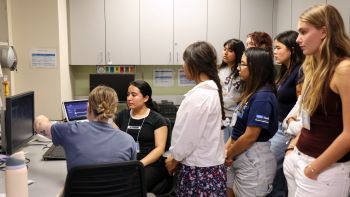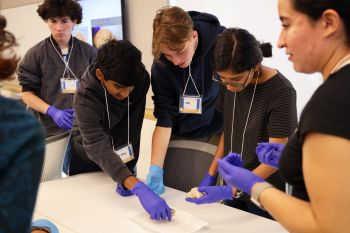Written by Anne Kelly, Roxy Zee, Anabel Gomez, Kimberly Gomez, and Analiz Lopez
This post was written by high school students from the UCLA Summer Research Boot Camp in Adolescent Development led by UCLA professor of education Sandra Graham and UCLA professor of psychology and CDA’s co-executive director Andrew Fuligni. This boot camp was facilitated by graduate students Ava Trimble, Jasmine Hernandez, and Clare McCann and was supported by the UCLA Center for the Developing Adolescent.
Adolescence marks a huge shift in development, when adolescents tend to branch out and become more independent. However, have you ever noticed how they’ll tend to stick together with those who look like them or have the same culture, even in diverse settings? The biggest question is why? During our time at the UCLA Summer Research Boot Camp, we were able to gain credible insight into this ‘why’ and learn how exposure to diverse friendships affects development.
Cross-Ethnic Friendships during Adolescence
The biggest takeaway we gained was how our social environment shapes who we are, especially during adolescence. While childhood friendships are formed based more on convenience, adolescent friendships grow deeper and are more identity-driven, marking adolescent friendships as incredibly powerful.
As we gained more background on this topic, an area that stood out to us was the importance of cross-ethnic friendships (friendships between people from different racial or ethnic backgrounds. Although some friend choices may seem superficial, who adolescents choose as friends can shape their beliefs, behaviors, and even their long-term attitudes toward diversity, setting up one’s mindset for the rest of their life.
Not only do friendships help adolescents explore who they are, but they also shape them into the person they become. Diverse friendships can help adolescents develop a more inclusive sense of identity and broaden their mindset as they are introduced to many cultures. Additionally, cross-ethnic friendships reduce prejudice and bias. Research suggests that sustained, meaningful contact – or a friendship – between people of different groups may lead to fewer stereotypes. This increases empathy and the ability to hold more diverse perspectives, contributing to less racial bias and more advocates for inclusion.
However, making diverse friendships isn’t always so easy. Even in ethnically diverse environments, adolescents tend to lean towards same-ethnic groups for familiarity–also known as “homophily.” Similarly, “propinquity” is making friends who are close in proximity, which is why it’s important for students to interact in diverse classrooms and environments. Although having friends from our same ethnic groups isn’t harmful, never forming cross-ethnic friendships can limit social learning and reinforce exclusion.
What Can Be Done to Promote Diversity?
School environment plays a crucial role in promoting diverse friendships. For example, who gets placed in advanced classes, which students join clubs or teams, and how teachers group students can all affect who students become friends with. There are many ways that teachers and administrators can promote cross-ethnic friendships, either by holding activities or mixing during group projects. This inclusion can not only benefit students emotionally, but has also been shown to improve academic performance while lowering levels of depression. Therefore, it’s important for schools to promote diversity and equal opportunity for classes, sports, and extracurricular activities, and implement programs to help students make friendships across barriers.



